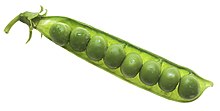Fabeae
| Fabeae | ||||||||||||
|---|---|---|---|---|---|---|---|---|---|---|---|---|

Pea ( Pisum sativum ) |
||||||||||||
| Systematics | ||||||||||||
|
||||||||||||
| Scientific name | ||||||||||||
| Fabeae | ||||||||||||
| Rchb. |
Fabeae is a tribe in the subfamily of the butterflies (Faboideae) within the legume family (Fabaceae). Its five genera and about 330 species occur mainly in the northern temperate latitudes, but also as far as tropical East Africa, South America and on Pacific islands. In important crop species belong to this tribe: the lens ( Lens culinaris ), the pea ( Pisum sativum ) and faba bean ( Vicia faba ).
description

Appearance and leaves
They are annual or perennial herbaceous plants . The stems grow upright, hanging or climbing on their own.
The alternately arranged, mostly stalked leaves are usually paired, very rarely pinnate unpaired. The leaf rhachis ends with a tendril, a bristle, a prickly tip or very rarely with a leaflet. The leaves are rarely reduced to phyllodes . Usually the leaves have from one to many pairs of pinna leaflet . The edges of the leaflets are mostly smooth, rarely toothed. The stipules are often foliage-like, unequal or almost arrow-shaped, in Pisum they are strikingly large; there are no stipules of the leaflets present.

Inflorescences and flowers
The flowers stand together individually or in groups in the leaf axils or too many in lateral, racemose inflorescences .
The hermaphrodite flowers are zygomorphic and fünfzählig with a double perianth (perianth). The five sepals are fused bell-shaped and end with five equal or unequal calyx teeth. The corolla has the typical structure of the butterflies. There are nine or all ten stamens fused together. The free area of the stamens is thread-like or widened in the lower area. The dust bags are all the same. There is an upper carpel that contains two or more ovules . The style is glabrous or hairy.
Fruits and seeds
The usually laterally flattened, two-fan legumes rarely contain only one, usually two or many seeds. The seeds are spherical, flattened, lenticular or oblong.
Systematics
The name Fabeae was first published in 1832 by Heinrich Gottlieb Ludwig Reichenbach in Flora germanica excursoria , 2 (2), p. 525. The type genus is the Faba Mill. Published in 1754 , today a synonym of Vicia L. published in 1753 , but Fabeae is the valid tribe name, whereas Vicieae DC is. - although published as early as 1825 - only a synonym ( International Code of Botanical Nomenclature , Vienna Code Art. 19.4).
External system
According to Steele and Wojciechowski (2003) the genus Trifolium forms the sister group to the Fabeae. The further relationship can be read from the following cladogram:
|
|||||||||||||||||||||||||
|
|
Internal system
The tribe Fabeae contains five genera with about 330 species:
- Flat peas ( Lathyrus L. ): It contains about 160 species widespread, mainly in the northern hemisphere ; some species are also found in South America .
- Lentils ( Lens Mill. ): It contains only four to six species, which are mainly native to the Mediterranean area to Central Asia , but also found in the Canary Islands and in tropical Africa . The lens is grown worldwide.
- Peas ( Pisum L. ): It contains only two or three species that are native to the Mediterranean region to Asia Minor . The pea is grown worldwide.
-
Vavilovia Fed. : It contains only one type:
- Vavilovia formosa (Steven) Fedorov : The home is in the Caucasus in southwestern Asia.
- Vetch ( Vicia L. ): It contains about 160 species mainly in the northern temperate areas; some species are also found in tropical Africa, Hawaii, and South America.
ingredients
The ingredients of many species were examined.
photos
Habitus, leaves with tendrils and inflorescences of Lathyrus tingitanus
Habitus, leaves and inflorescences of Lathyrus vestitus subsp. alefeldii
Lentil ( Lens culinaris )
Flowering peas ( Pisum sativum )
Habit, leaves and inflorescence of Vicia americana
Vicia pannonica leaves and inflorescence
swell
- Bojian Bao, Nicholas J. Turland & Gregory Kenicer: Fabeae , p. 560 - online with the same text as the printed work , In: Wu Zheng-yi, Peter H. Raven & Deyuan Hong (eds.): Flora of China , Volume 10 - Fabaceae , Science Press and Missouri Botanical Garden Press, Beijing and St. Louis, 2010. ISBN 978-1-930723-91-7 (section description and classification)
Individual evidence
- ↑ First publication online.
- ↑ KP Steele, MF Wojciechowski: Phylogenetic analyzes of tribes Trifolieae and Vicieae, based on sequences of the plastid gene, matK (Papilionoideae: Leguminosae) . In: B. Klitgaard, A. Bruneau (Eds.): Advances in Legume Systematics. Part 10, Higher Level Systematics . Kew: Royal Botanic Gardens , Kew 2003, ISBN 1-84246-054-4 , pp. 355-370 ( online [PDF]).
- ^ Fabeae in the Germplasm Resources Information Network (GRIN), USDA , ARS , National Genetic Resources Program. National Germplasm Resources Laboratory, Beltsville, Maryland. Retrieved July 16, 2013.
- ↑ Bojian Bao, Nicholas J. Turland & Gregory Kenicer: Fabeae , p. 560 - online with the same text as the printed work , In: Wu Zheng-yi, Peter H. Raven & Deyuan Hong (eds.): Flora of China , Volume 10 - Fabaceae , Science Press and Missouri Botanical Garden Press, Beijing and St. Louis, 2010. ISBN 978-1-930723-91-7
- ↑ Enter the taxon in the search mask at International Legume Database & Information Service = ILDIS. Last accessed July 16, 2013
- ^ Robert Hegnauer: Chemotaxonomie der Pflanzen , Volume XIB-2, Springer, 2001. ISBN 3-7643-5862-9 : Online at Google Books (Vicieae: page 691-770)






